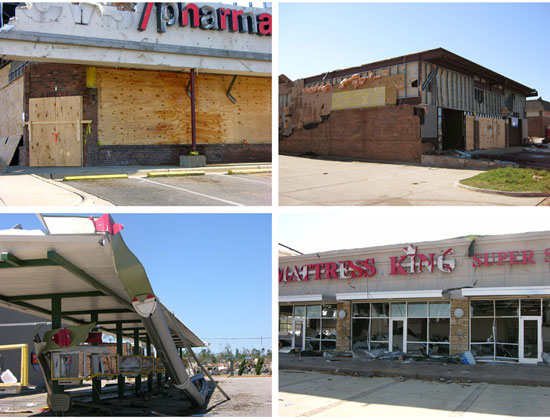April 22-28 US Severe Thunderstorm Outbreak
Status: Closed
| Type of posting | Posting date(EST): | Summary | Downloads |
|---|---|---|---|
| Update 1 | 5/9/2011 4:30:00 AM |
|
|
| First Posting | 4/29/2011 1:00:00 PM |
|
Update 1 | Summary
Posting Date: May 9, 2011, 4:30:00 AM
AIR Worldwide estimates that insured losses to residential, commercial and industrial properties and their contents, and to automobiles from the severe thunderstorm outbreak that struck the U.S. from April 22–April 28, 2011, are between USD 3.7 billion and USD 5.5 billion. The event has been issued Catastrophe Serial Number 46 by ISO's Property Claim Services® (PCS®).
Summary of the Outbreak
One week after a violent severe weather outbreak across the Southern and Southeastern United States, thousands of federal, state, and local disaster response personnel and inspectors remain on the ground to provide emergency relief and security, perform damage assessments, clear debris, and plan recovery efforts. The death toll from the events of April 25–April 28 is currently estimated at 354 across seven states, and thousands have been left homeless when entire neighborhoods were flattened to the ground. It is the second deadliest severe thunderstorm outbreak in U.S. history, after the Tri-State tornado outbreak of 1925.
Based on preliminary assessments, the Mississippi Emergency Management Agency reported 2527 homes damaged, including 993 severely damaged or destroyed, and 104 damaged businesses, including 62 severely damaged or destroyed. The Virginia Department of Emergency Management reports initial estimates of 443 damaged structures, including 137 destroyed or severely damaged. In Georgia, where the governor has declared a state of emergency in 27 counties, an EF-4 tornado touched down in Cartoosa County with winds of 175 mph, damaging or destroying 75–100 homes.
In Alabama, the worst affected state where 38 of 67 counties have been declared as disaster areas, the insurance commissioner has indicated that losses could reach those from Hurricane Ivan (2004) in his state. Information compiled by the American Red Cross points to as many as 5000 properties destroyed in Tuscaloosa alone, a town particularly hard hit on April 27 by a long duration EF-4 tornado with a track length of 80 miles.
The Storm Prediction Center (SPC) of the National Weather Service (NWS) has reported more than 475 eyewitness tornado sightings over the four day period from April 25–April 28. Of these, more than 200 tornado touchdowns have been confirmed by NWS damage surveys, including two EF-5s (which are characterized by wind gusts of over 200 mph). These two—the Smithfield tornado in Mississippi and the Hackleburg tornado in Alabama—both occurred on April 27, marking the first time in more than 20 years that two EF-5s occurred on the same day. The number of fatalities from the two tornadoes combined is close to 100. A total of 12 EF-4 tornadoes (with gusts of 166–200 mph) have been confirmed, and many of these—including the exceptionally damaging Tuscaloosa-Birmingham tornado that remained on the ground for 90 minutes—had path lengths exceeding 70 miles.
Across the South, more than 34,000 people (mostly in Alabama, Mississippi, Georgia, Tennessee and Virginia) have registered for disaster assistance from FEMA, which has thus far provided more than $13.6 million in grants for temporary housing, repairs, and other emergency assistance.
The Tuscaloosa Tornado: Preliminary Damage Survey Findings
Last week, after search and rescue efforts had largely ceased, an AIR post-disaster survey team visited the worst-hit areas of Alabama around Tuscaloosa and Birmingham to assess building performance, wind speeds, and damage footprints. (AIR will make additional survey findings available in the weeks ahead.)
AIR engineers were particularly interested in the relative performance of commercial structures in the center of the tornado’s track and those on the periphery. Structures located on a tornado’s periphery can be severely damaged as a result of missile impacts (i.e., airborne debris) and strong inflow winds, with the result that the overall damage footprint is effectively widened.
In areas of Tuscaloosa affected by the EF-4 tornado, large commercial structures including those that housed Big Lots and Hobby Lobby stores, were reduced to rubble. Many properties closer to the periphery of the tornado sustained significant damage to their roofs and openings (large plate glass windows and doors). With the building envelope breached, many sustained subsequent structural damage. Examples are shown in the figure below. The residential community north of 15th Street East, which was in the direct path of the tornado, was completely destroyed.
 Figure 1. Damage to commercial structures on the periphery of the EF-4 Tuscaloosa, Alabama tornado. Residential structures closer to the center of the track were largely flattened. Source: AIR
Figure 1. Damage to commercial structures on the periphery of the EF-4 Tuscaloosa, Alabama tornado. Residential structures closer to the center of the track were largely flattened. Source: AIR  Figure 2. AIR cleaned dataset of microevents spanning the period from April 22–28. Source: AIR
Figure 2. AIR cleaned dataset of microevents spanning the period from April 22–28. Source: AIR